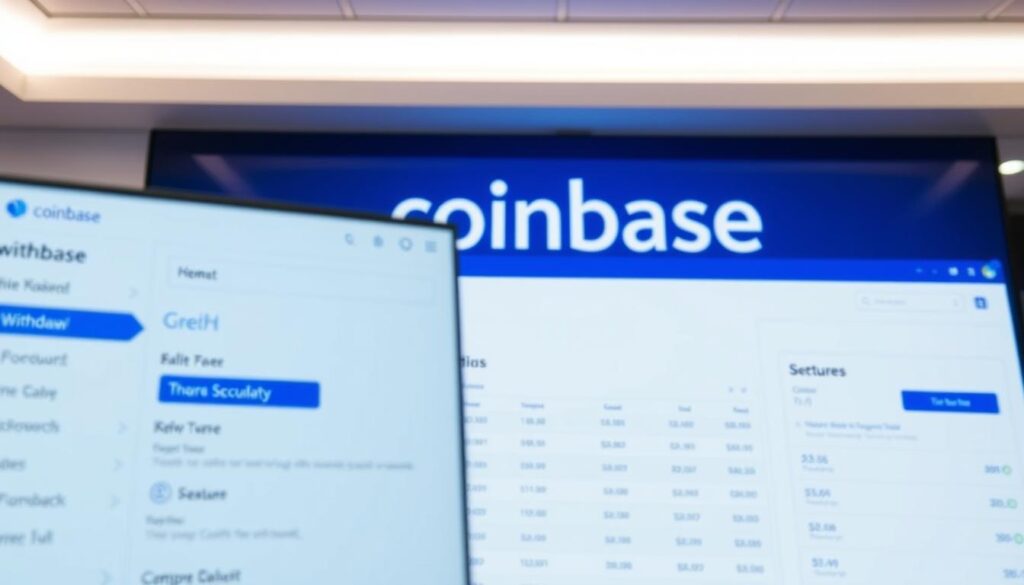Now Reading: Safest Crypto Exchanges for Large Investments: Expert Insights
- 01
Safest Crypto Exchanges for Large Investments: Expert Insights
Safest Crypto Exchanges for Large Investments: Expert Insights

This guide helps U.S. investors pick platforms that balance security, liquidity, and clear fees.
We look at regulated access, custody practices, and responsive support so big orders clear smoothly. Major names covered include Coinbase, Gemini, Kraken, Crypto.com, Uphold, Interactive Brokers, Fidelity, Binance.US, BitFlyer, and eToro.
Deep liquidity and maker/taker pricing shape execution quality. OTC desks, withdrawal timelines, and fee caps can matter more than headline rates when moving significant assets.
Security basics include insurance, cold storage, MFA, and allowlisting. Note that traditional SIPC protection does not extend to cryptocurrencies, so custody choices are key.
Finally, compare staking opportunities, support responsiveness, and reporting tools. Plan an end-to-end workflow from buy/sell to wallet and tax reporting to keep holdings aligned with risk policies and operational needs.
Why Security Comes First for High-Net-Worth Crypto Investors
Protecting significant digital assets starts with institutional controls that reduce counterparty and operational risk. Large allocators demand segregated custody, audited procedures, and hardware security modules to limit exposure from platform failures or breaches.

Institutional-grade safeguards and why they matter now
Segregated custody and multisignature policies keep most holdings offline in cold storage. That practice cuts hot wallet exposure and lowers the chance of a mass loss after a hack.
Withdrawal allowlists, step-up confirmations, and dedicated compliance teams further reduce unauthorized movements. Robust KYC/AML programs help prevent fraud when moving large sums across accounts.
Cold storage, insurance, and operational risk in the U.S. market
Insurance can exist, but coverage often excludes market losses and may not cover every on-exchange balance. Investors should review policy limits and claim history before trusting a platform.
- Operational resilience: disaster recovery plans and incident response matter for uptime and trust.
- Fiat rails & settlement: reliable cash handling affects timing when executing sizable trades.
- Support SLAs: dedicated account managers and escalation paths speed problem resolution.
- Staking & lending: added yield services increase counterparty complexity and may warrant reduced exposure.
Layered security—MFA, hardware keys, device hygiene, and unique credentials—reduces account-takeover risk during active trading. Align platform choice with U.S. availability and compliance to keep assets operational and legally sound.
How We Evaluated Platforms for Safety and Scale
Our evaluation blends hands-on testing with disclosed metrics to judge safety and scale across providers. We prioritized observable controls and real-world performance over marketing claims.
Security, storage, and breach history
Security posture took top weight. We reviewed cold storage ratios, multisig use, insurance limits, and past incidents. Breach timelines and remediation steps informed risk scores.
Fees, liquidity, and supported coins
We compared maker/taker tiers, funding costs, withdrawal charges, and network fees that affect execution. Deep market liquidity and broad coin coverage reduce slippage when scaling trades.
Staking, features, and consumer sentiment
Staking availability and custody rules were checked against U.S. eligibility. We also measured user reports and support quality during volatile periods to gauge operational reliability.
U.S. availability, compliance, and customer support
Platform feature sets vary by state. We verified listed coin counts, fee tiers, and security claims on each website at time of review. Educational resources and clear status pages earned extra credit for institutional onboarding.
- Scoring blend mirrors Forbes’ weighted variables and NerdWallet’s hands-on approach.
- We balanced quantitative metrics with professional judgment on operational risk.

| Criteria | Weighting (example) | What we checked |
|---|---|---|
| Available coins | 20% | Count, regional availability, trading pairs |
| Trading & fees | 15% | Maker/taker tiers, funding, withdrawal costs |
| Security & storage | 15% | Cold storage %, multisig, insurance, breach history |
| Consumer sentiment | 17% | Support response, incident handling, reviews |
| Additional features | 10% | Staking, OTC, advanced orders, APIs |
Kraken: Deep Liquidity and Pro Tools for Serious Traders
Kraken pairs deep order books with pro-grade tools to help traders scale positions with less slippage. The platform lists 400+ assets and supports many key pairs that matter when executing big orders.

Maker/taker tiers and 30-day volume
Fees start competitive and fall as volume grows. Forbes cites maker 0.25% / taker 0.40% for under $10,000 in 30-day volume, with tighter rates at higher tiers.
Order types, futures access, and custody
Kraken supports limit, stop, stop-limit, and advanced conditional orders to stage entries and manage downside while scaling positions.
Futures access exists in some jurisdictions, useful for hedging while managing spot inventory and custody exposure.
- Custody controls: cold storage practices, address allowlisting, and withdrawal confirmations.
- Connectivity: robust APIs and throughput for automated trading and algos.
- Funding & settlements: fiat rails and funding timelines affect how fast teams can deploy or rebalance capital.
- Operational advice: test app and website workflows; document user permissions and approval chains.
| Feature | Notes | Impact on trades | Best use |
|---|---|---|---|
| Asset coverage | 400+ coins listed | Lower slippage on many pairs | Wide-market access |
| Fee tiers | Maker 0.25% / Taker 0.40% (base) | Compresses with volume | Scale to reduce costs |
| Order types | Limit, stop, stop-limit, conditional | Precision entry & risk control | Staged entries and exits |
| APIs & custody | High-throughput APIs; cold storage & allowlists | Reliable automation; stronger controls | Algo trading and institutional custody |
Coinbase Exchange: Largest U.S.-Based Platform With Quick Withdrawals
Coinbase leads U.S. platforms with broad asset access and fast withdrawal rails that suit institutional workflows. The site lists 200+ cryptocurrencies and offers clear documentation on which coins are available to U.S. users.

Transparency on availability and uptime helps compliance teams map policies and operational windows. Coinbase’s status pages and developer docs make it easier to plan settlements and automated flows.
Fees vary by order type and funding method. Maker orders and native exchange funding usually lower blended trading costs. Credit or debit payments often carry higher fee rates, so high-volume teams route liquidity through exchange balances or bank rails when possible.
- Withdrawals: Quick on-chain sends when addresses are pre-validated and allowlisted.
- Liquidity: Deep books in top pairs and OTC options to reduce market impact.
- Tools: Active/Advanced interfaces, APIs, and enterprise docs for automation and pre-trade checks.
- Support: Dedicated escalation paths matter when timing is critical.
| Aspect | What to check | Practical tip |
|---|---|---|
| Asset coverage | 200+ coins / regional limits | Confirm token support and withdrawal minimums |
| Fees & funding | Varies by payment method and order type | Use maker orders and native funding to lower costs |
| Withdrawals & custody | Fast rails; allowlisting recommended | Pre-validate addresses and test small sends |
| APIs & ops | Well-documented endpoints and status pages | Test API workflows before live execution |
Balance convenience against potentially higher fee profiles. Test interfaces, align account permissions, and require hardware security keys for operators handling high-value token moves.
Gemini: Regulated, Available in All U.S. States
Gemini’s nationwide licensing makes it a straightforward choice for teams that need predictable state-by-state coverage. The platform is authorized across the U.S., which eases onboarding and compliance checks for institutional accounts.
Security-first design is central to Gemini’s value proposition. Institutional-grade custody, audited controls, and multi-layer confirmations support larger on-exchange balances.
Institutional custody and operational controls
Gemini offers segregated custody options and withdrawal allowlists that reduce operational risk. Those features suit teams that require strict approval workflows and clear audit trails.
Fees, ActiveTrader, and trading coverage
Headline fees can be higher on the retail app and website. That trade-off can make sense when reliability and regulatory clarity matter.
The ActiveTrader interface expands pairs (100+ crypto-to-crypto) and lowers costs versus the basic UI. Evaluate API routing and test ActiveTrader for high-volume order strategies.
- Staking: Available to eligible U.S. users; weigh yield against counterparty and regulatory risk.
- Support & escalation: Documented customer paths matter for large account events.
- Withdrawal planning: Pre-validate addresses, set allowlists, and test small sends before big moves.
| Feature | Note | Action |
|---|---|---|
| U.S. availability | Every state | Good for nationwide compliance |
| Custody | Institutional-grade | Use for operational controls |
| Fees | Higher on retail UI | Compare all-in costs vs other venues |
Teams should compare all-in fees, settlement timing, and per-transaction minimums when sizing single large tickets versus staged orders. Consider self-custody for long-term holdings and review detailed schedules before committing volume.
Learn more about Gemini’s trading tools and institutional services on the Gemini ActiveTrader page.
Crypto.com: Broad Asset Access With Cash-Transfer Fee Advantages
Crypto.com combines broad token coverage with cash-transfer perks that cut funding friction. For U.S. teams, low or no fees on ACH or bank wires can reduce the total cost of onboarding capital versus card routes.
Watch outbound costs: on-chain withdrawals may carry higher fees and larger minimums. Model these costs when planning big sends to custodians or self-custody wallets.
The platform lists many assets and tokens, which helps diversify exposure across coins. Liquidity varies by pair, so test execution and consider OTC to limit slippage in thin markets.
- Staking: straightforward programs exist, but some staking services and rewards differ for U.S. users due to compliance.
- Operational tips: enable two-factor, set withdrawal allowlists, and require approval chains for high-value moves.
- Execution: check how fee schedules interact with maker/taker pricing and stage entries to improve average execution cost.
| Feature | Practical note | Action |
|---|---|---|
| Cash transfers | Low/no fees | Use bank rails for large deposits |
| Withdrawals | Higher minimums possible | Model outbound fees before moving assets |
| App & web tools | Order controls and alerts | Test workflows and API routes |
Verify U.S. availability for specific services before onboarding. Periodically review fees and updates on the company site, and consult a top crypto exchanges comparison when weighing alternatives.
Uphold: Thousands of Trading Pairs and Strong Staking
Uphold’s multi-asset design makes it easy to move between fiat, metals, and digital tokens without jumping between wallets. The site lists thousands of trading pairs and a broad set of assets that help with diversified portfolio construction.
Multi-asset access and staking yield considerations
Staking options are broad, but reward rates vary by token and may include lockups or platform-specific terms. Large allocations should weigh counterparty risk and variable yields before committing funds.
Transaction fees and customer support realities
Transaction spreads and listed fees can be higher than some peers. Model total cost, including spreads and network fee, for recurring, high-value orders to avoid surprises.
- Pre-trade test low-liquidity pairs to measure slippage.
- Consider OTC routes for block trades to limit market impact.
- Build internal redundancies: ticketing + escalation, since customer support lacks live phone options.
- Use strong MFA and address allowlisting across wallets.
- Plan API-based monitoring and reconciliation for multi-venue strategies.
| Feature | Impact | Recommended action |
|---|---|---|
| Thousands of pairs | Easy diversification across coins and tokens | Verify pair availability on the website before trading |
| Staking programs | Variable yield; possible lockups | Read terms and model reward volatility |
| Support & fees | Slower ticket response; wider spreads | Test flows, use OTС for big blocks, and plan escalations |
Interactive Brokers: Established Brokerage With Capped Crypto Fees
Interactive Brokers blends traditional brokerage controls with digital-asset access. The platform caps commissions at up to 1% of trade value, which creates a predictable cost model for institutions planning sizable orders.
Up to 1% fee cap and fiat rails for large orders
The capped fee model helps teams forecast expenses and compare venues without guesswork. IB supports BTC, ETH, LTC, and BCH via integrated fiat rails that streamline funding and settlement alongside standard brokerage accounts.
There is no staking, which reduces counterparty complexity but limits yield options for treasury strategies. Customer support and account teams tend to be responsive during high-pressure events, and that support often compares favorably to many pure-play venues.
- Test order sizes and partial fills to measure liquidity and execution.
- Use the app and website for execution oversight and post-trade reporting.
- Set user roles, approvals, and predefine withdrawal workflows if assets move off-platform.
- Monitor fee schedules and coin support as brokerage services evolve.
| Feature | Note | Action |
|---|---|---|
| Fee cap | Up to 1% commission | Plan large trades with predictable cost |
| Asset coverage | BTC, ETH, LTC, BCH | Best for focus on major assets |
| Staking | Not offered | Weigh yield trade-offs vs. counterparty risk |
Fidelity and Bitstamp by Robinhood: Limited Coins, Strong Brand Backing
Household brokerage names now offer constrained token menus and clearer fiat rails. That setup suits teams that prefer simpler workflows and familiar compliance controls while keeping access to major cryptocurrencies.
Fidelity’s major-coin access and transfers
Fidelity supports Bitcoin, Ethereum, and Litecoin. In 2025 it added send/receive, which improves custody moves and treasury workflows.
Practical tip: test small transfers to external custodians before moving significant balances.
Bitstamp liquidity via Robinhood
Robinhood sources exchange liquidity from Bitstamp but lists fewer coins and no crypto-to-crypto trading. That limits trading tactics but keeps funding straightforward.
- Fees: spreads can be the larger cost—model total execution expense, not just visible commission.
- Use partial fills and timed orders to reduce market impact when menus are thin.
- Check support and escalation paths; responsiveness can lag compared with pure-play venues during volatility.
| Platform | Coin coverage | Notable limits | Primary benefit |
|---|---|---|---|
| Fidelity | BTC, ETH, LTC | Fewer tokens; recent send/receive | Brokerage integration & trust |
| Robinhood (Bitstamp) | Limited list | No crypto-to-crypto trading | Simple rails; external liquidity |
| Advice | — | Model fees, test transfers | Good for conservative allocations |
Binance.US, BitFlyer, and eToro: Access and Limitations for U.S. Users
Platform choice often comes down to whether low trading costs or wider token access matters more to your strategy. Below we compare three U.S.-facing venues on fees, coin lists, and operational trade-offs.
Fee competitiveness vs. coin availability
Binance.US lists roughly 160+ assets with a 0.1%/0.1% maker/taker schedule that delivers consistently low fees on spot trades. State-level feature limits can affect routing and certain order types.
BitFlyer advertises fees as low as 0.10% but supports only nine coins. That low-fee profile reduces trading cost, yet it restricts diversification for a broad portfolio.
eToro charges about 1% plus the spread. Globally it lists 100+ cryptocurrencies, but U.S. users can access only 19 tokens. The narrower U.S. menu can constrain institutional strategies.
Execution, liquidity, and operational notes
- Top-pair liquidity matters more than headline fees; thin books may require OTC to limit slippage.
- App and website controls differ: order types, disclosures, and risk warnings affect pre-trade planning.
- Customer support paths vary and can impact time-sensitive withdrawals or compliance checks.
- Regularly confirm token availability and transfer support; listings can change.
| Platform | Typical fee | U.S. coin count |
|---|---|---|
| Binance.US | 0.1% / 0.1% | ~160+ |
| BitFlyer | As low as 0.10% | 9 |
| eToro (U.S.) | ~1% + spread | 19 |
Practical tip: model total cost of ownership—trading fees, spreads, and withdrawal charges—and maintain secondary accounts for redundancy if access becomes temporarily limited.
Fees and Liquidity: Optimizing Execution for Large Transactions
Optimized execution blends staged orders, venue checks, and pre-funded accounts to reduce slippage. Plan trades around maker/taker schedules, funding rails, and available liquidity rather than headline rates alone.
Maker vs. taker strategy when scaling into positions
Maker orders often lower trading costs on tiered fee tables. Use limit orders to add liquidity and qualify for maker rebates on platforms with volume tiers.
Taker fills buy immediacy. They can be worth the fee when time-sensitive execution or risk reduction matters.
Slippage control, OTC, and funding method fees
Stage entries with laddered limits across pools to reduce market impact and average into a position. If order books are thin, consider OTC desks to avoid slippage on a single block trade.
Funding choices change total cost. Cash transfers (ACH or wires) can be low or free on some platforms, while cards and on-chain withdrawals may add significant fees. Interactive Brokers’ fee cap (up to 1%) provides predictable budgeting for big moves.
- Cross-venue liquidity checks and smart order routing help find the best fills.
- Stress-test withdrawal throughput and fees during peak network load to avoid surprises.
- Maintain pre-approved addresses, pre-funded accounts, and contingency OTC lines in volatile markets.
| Platform | Representative fee | Execution note |
|---|---|---|
| Kraken | Maker 0.25% / Taker 0.40% ( | Tiers improve with volume; use maker orders to lower cost |
| Binance.US | 0.10% / 0.10% | Low base fees; check state-level feature limits |
| Crypto.com | Maker 0.25% / Taker 0.50% ( | Cash transfers may be low; model withdrawal minimums |
| Interactive Brokers | Fee cap up to 1% | Predictable commissions; limited token set |
After each trade, reconcile fills, fees, and realized slippage. Audit fee assumptions regularly to refine execution playbooks and preserve returns when scaling across platforms.
Security Checklist for Large Crypto Allocations
A concise set of defensive controls will limit exposure during trading and custody events. Follow a simple, repeatable checklist before moving assets or funding an account.
MFA, allowlisting, withdrawal confirmations, and device hygiene
Require phishing-resistant MFA such as hardware security keys for any account that can sign transfers. Enforce unique passwords, device hygiene, and restricted admin roles to reduce internal risk.
Use address allowlisting and multi-operator withdrawal confirmations for high-value sends. Log and audit every approval to create an immutable trail for compliance and incident review.
Exchange wallet vs. self-custody: when to use each
Keep funds on an exchange wallet only while actively trading or when collateral is required. Move long-term holdings to self-custody or a qualified custodian to reduce counterparty exposure.
Test small transfers before large moves and document custody workflows for all users and signers.
Insurance nuances and counterparty risk
Platform insurance often has limits and exclusions; it is not a substitute for controls. Review disclosures and cap exposure per venue. Simulate incidents to validate incident response steps and confirm support availability.
- Catalog token-specific risks (contracts, wrapped assets, staking derivatives).
- Maintain offline backups for seeds with tamper-evident storage and in-person controls.
- Periodically reassess policies as platforms, token rules, and regulation change; consult a how-to guide when choosing venue options.
| Risk area | What to check | Action |
|---|---|---|
| Insurance | Coverage limits & exclusions | Read disclosures; do not rely solely on policies |
| Support | Escalation SLA & recovery paths | Test response with simulated incidents |
| Counterparty | Operational history & custody model | Cap exposure and diversify storage |
Staking and Yield: Balancing Rewards With Platform Risk
Staking can boost yield but requires careful checks on platform rules and lockup terms. Rewards add return, yet they change liquidity and operational needs.
Which U.S. platforms offer staking and on what assets
Uphold offers extensive staking across many assets. Crypto.com runs a straightforward program, though some U.S. services are limited. Gemini and Coinbase have offered staking with evolving availability. Interactive Brokers and Fidelity do not provide staking.
- Map supported coins and typical reward rates before committing assets.
- Account for lockups, unbonding windows, and how they affect trading plans.
- Compare custodial staking (platform-controlled) versus on-chain delegation; smart contract and counterparty risk differ.
- Model net yield after platform fees and compounding schedules.
- Document approvals, cap exposure per platform, and contingency plans for validator downtime or slashing.
| Platform | Staking | Notes |
|---|---|---|
| Uphold | Yes | Wide asset list; check lockups |
| Crypto.com | Yes (limited U.S.) | Simple UX; some tokens restricted |
| Coinbase / Gemini | Selective | Availability changes; watch terms |
Platform Experience: Order Types, APIs, and Educational Resources
Order type depth and API reliability shape how teams scale positions and manage execution risk. Look for platforms that offer limit, stop, stop-limit, trailing stops, and OCO orders to automate discipline when placing big trades.
Stop-limit, advanced orders, and automation readiness
Advanced order sets let traders ladder entries and protect downside without constant oversight. Kraken and Crypto.com publish clear maker/taker schedules that feed automation rules and cost estimates.
Evaluate API maturity: check rate limits, order routing, and error handling. Reliable APIs reduce failed trades and help reconciliation.
In-platform education for newer team members
Coinbase, Gemini, and Uphold provide solid educational resources on their website and apps. These materials speed onboarding and harden operational hygiene.
Require sandbox testing before moving automation to production. Run tabletop exercises to train users on error handling and escalation with platform support.
- Approval workflows: multi-user roles, two-step approvals, and audit logs.
- Latency & uptime: monitor during volatile sessions; prefer platforms with published SLAs.
- Reporting: exportable trades, fee reports, and accounting integrations.
| Feature | Why it matters | Practical action |
|---|---|---|
| Advanced orders | Reduce slippage and automate risk limits | Test OCO and trailing stops in sandbox |
| API reliability | Prevents failed or duplicated orders | Measure error rates and rate limits before rollout |
| Educational resources | Speeds safe onboarding of new users | Require completion of platform tutorials and drills |
Methodologies Behind “Best” and “Safest” Rankings
Our ranking blends numeric scores, hands-on testing, and direct vendor checks to produce actionable ratings. We balance measurable metrics with qualitative insight so investors can map ratings to real workflows.
Data collection and scoring framework
Quantitative inputs came from fee schedules, coin counts, withdrawal limits, and documented security controls. We used platform websites, API tests, and fee audits to ensure accuracy.
Editorial independence and validation
Independent review mirrors NerdWallet’s approach: questionnaires, demos, interviews, and hands‑on testing support star ratings. We verify claims with provider responses and repeat tests periodically to capture changes.
- Weightings follow a Forbes-like model emphasizing coins, trading fees, and security.
- Customer support and educational resources inform qualitative adjustments.
- U.S. regulatory posture and USD availability shift scores where relevant.
| Criteria | Weight | Why it matters |
|---|---|---|
| Available coins | 20% | Diversity reduces single-market risk |
| Trading fees & liquidity | 15% | Directly affects execution cost and slippage |
| Security & storage | 15% | Protects assets and reduces counterparty risk |
| Consumer sentiment & support | 17% | Operational recovery and escalation matter for big accounts |
Conclusion
A practical trading plan ties venue choice, security, and execution into a repeatable process. Match each platform to the coins you need and confirm U.S. access, withdrawal timing, and support before moving material balances.
Optimize fees by using maker orders and low‑cost cash rails where available, model network and withdrawal costs, and consider OTC to limit slippage. Break orders, monitor spreads, and reconcile fills after every trade.
Enforce account controls: MFA, allowlisting, multi‑operator approvals, and periodic security drills. Keep secondary platforms for redundancy and document an end‑to‑end buy/sell, custody, and reconciliation workflow to support governance and audits.
Shortlist two or three platforms, run small live tests, validate withdrawals, then scale allocations with verified controls in place.
FAQ
What should high-net-worth investors prioritize when choosing a trading platform?
Prioritize institutional-grade security, transparent custody arrangements, strong liquidity for large orders, and clear compliance with U.S. regulations. Look for platforms with cold storage, third-party audits, insurance coverage, and an established operational history to reduce counterparty and operational risk.
How do cold storage and insurance reduce operational risk?
Cold storage keeps the majority of assets offline, limiting exposure to online attacks. Insurance covers certain losses from theft or breaches, though policies vary in scope and exclusions. Together they lower recovery risk and offer added protection compared with platforms that rely mainly on hot wallets.
How did you evaluate platforms for security and scale?
We assessed breach history, custody models, third-party audits, and operational controls. We also measured liquidity, fees, supported coins, staking options, customer support responsiveness, and U.S. availability to gauge how each platform handles large orders and ongoing risk.
Why does liquidity matter for large trades?
High liquidity reduces slippage and market impact when placing sizable orders. Platforms with deep order books and institutional desks or OTC desks let investors execute large fills at competitive prices, avoiding costly price moves during execution.
What fee factors should institutional investors consider?
Look at maker and taker fees, volume tiers, withdrawal costs, and any caps on fees for large trades. Also consider funding costs, wire transfer fees, and the difference between retail app pricing and professional exchange fee schedules to optimize execution.
How do staking and yield features affect platform risk?
Staking offers yield but introduces lock-up, counterparty, and smart-contract risks. Verify validator selection, unstaking periods, and the platform’s risk-sharing model. Balance yield opportunities with the potential for service outages or emerging protocol vulnerabilities.
When should I use an exchange wallet versus self-custody?
Use exchange custody for active trading, margin, or staking when speed and access matter. Use self-custody for long-term holdings where you control private keys. For very large allocations, consider splitting holdings and using institutional custody solutions for a hybrid approach.
How important is customer support for large accounts?
Very important. Dedicated account managers, fast response times, and escalation paths matter when troubleshooting large transfers, compliance holds, or settlement issues. Prefer firms that offer phone support and institutional onboarding teams.
Are U.S.-based platforms safer for compliance and legal recourse?
U.S. platforms typically operate under clearer regulatory frameworks and may offer stronger legal recourse and transparency. However, safety still depends on a firm’s controls, audits, and custody model, not just headquarters location.
What execution strategies reduce slippage for big orders?
Use limit orders, split orders over time, employ algorithmic execution tools, or route trades through OTC desks. Maker/taker fee awareness and volume-tier pricing also influence whether to place passive or aggressive orders to minimize cost.
How do OTC desks differ from exchange order books?
OTC desks facilitate direct, off-book trades that limit market impact. They offer price certainty and block trade handling, often with AML/KYC checks and settlement via fiat rails. OTC is preferable for very large trades that would otherwise move public order books.
What are common red flags in platform security or operations?
Red flags include unclear custody practices, lack of third-party audits, frequent service outages, opaque fee schedules, slow or nonexistent customer support, and histories of unresolved breaches or regulatory actions.
Which U.S. platforms commonly offer staking and which assets are supported?
Major U.S. platforms that list staking include Coinbase, Kraken, and Crypto.com, typically supporting assets like ETH (where applicable), SOL, ADA, and DOT. Offerings vary by platform, and yield rates, lockup windows, and custody models differ.
How should investors verify an exchange’s insurance and audit claims?
Request policy details, coverage limits, and exclusions. Check for up-to-date SOC or financial audit reports and review independent attestations. Confirm whether coverage extends to customer assets versus the firm’s own reserves.
What role do APIs and advanced order types play for institutional users?
Robust APIs and advanced order types enable automation, algorithmic execution, and better risk management. Features like stop-limit, TWAP/VWAP, and FIX connectivity help institutions scale trading and integrate with portfolio systems.
How can investors control counterparty risk when using multiple platforms?
Diversify custody across reputable providers, limit balances on any single platform, enable multi-factor authentication and withdrawal allowlists, and use institutional custody services or qualified custodians for large allocations.
What compliance checks should U.S. investors expect during onboarding?
Expect AML/KYC documentation, source-of-funds verification, beneficial ownership disclosure for entities, and additional diligence for high-volume or institutional accounts. Preparing documents in advance speeds onboarding.
How do funding methods affect fees and settlement speed?
Bank wires typically support large fiat transfers with predictable settlement and lower per-dollar fees. ACH may be cheaper but slower and limited for big sums. Credit card and debit options are costly and unsuitable for large deposits.
What educational resources should platforms provide for institutional teams?
Platforms should offer clear API docs, custody and settlement guides, market structure explanations, compliance resources, and training modules for trading desk staff to ensure safe and compliant operations.
How often should investors review platform security and policy changes?
Review quarterly or whenever a platform announces major policy, custody, or leadership changes. Regular audits of account permissions, withdrawal rules, and access controls help maintain security posture.












